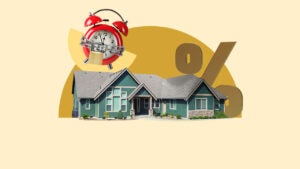What is Fannie Mae HomePath?

Key takeaways
- The Fannie Mae HomePath program offers an opportunity for homebuyers to purchase foreclosed, forfeited or short sale properties, potentially at a lower price.
- The HomePath program helps promote homeownership by offering inventory to homebuyers first, ahead of investors.
- While HomePath properties are often more affordable, they are also sold “as is” and might require significant repairs.
If you’ve been searching for an affordable home, you might have come across Fannie Mae’s HomePath program. Here’s what to know about this homebuying initiative.
What is the Fannie Mae HomePath program?
HomePath is a program that allows homebuyers and investors to purchase homes that Fannie Mae has repossessed due to foreclosure, short sale or forfeiture. Fannie Mae is a government-sponsored enterprise that supports the U.S. housing finance system.
HomePath properties are often available at lower prices, but they’re also sold in as-is condition. In some cases, Fannie Mae makes repairs to homes prior to offering them for sale.
Fannie Mae HomePath properties
Fannie Mae HomePath properties include single-family homes, condos and townhouses. The property could be in move-in ready condition, but more likely, it’ll need either some or extensive repairs.
Why does Fannie Mae sell HomePath properties?
Who is eligible for HomePath?
To be eligible to buy a HomePath property, you’ll need to live in the property as your primary residence within 60 days of closing.
If you’re not paying cash, you’ll also need to qualify for a mortgage to buy the home. Fannie Mae backs several different financing options, including:
- HomeReady loan: To be eligible for this conventional loan, you’ll need to have a credit score of at least 620 and a down payment of at least 3 percent. Additionally, your income can’t exceed 80 percent of the area median income (AMI) for the home’s location. You can use Fannie Mae’s AMI tool to find out your area’s limits.
- HomeStyle renovation loan: This mortgage finances the home’s purchase and repairs in one loan. The repairs can’t exceed 75 percent of the post-renovation value of the home.
- HFA Preferred loan: This is another type of conventional loan offered through state housing finance agencies. You’ll need to meet your state’s credit, income and purchase price conditions to qualify.
Fannie Mae also facilitates the HomePath Ready Buyer program, a combo closing cost assistance and homebuyer education course. If you’re a first-time buyer who successfully completes the course, you could get up to 3 percent in closing cost assistance.
Keep in mind: If you’re obtaining an HFA Preferred loan through your state housing finance agency, you might qualify for 3 percent assistance, as well. In addition, buyers with incomes at or below 100 percent of the AMI in the HomePath property’s location might also qualify for closing cost assistance.
How to get a HomePath property
Fannie Mae sells HomePath properties to homebuyers as well as investors and community organizations.
Typically, it’ll first open the listing to homebuyers and some non-profits or public entities for 30 days. If the property doesn’t sell within that time, investors can then make offers. Alternatively, Fannie might decide to auction the home online.
HomePath listings are available at homepath.fanniemae.com. They’re listed by real estate agents, but the listings tend to have fewer details compared to other real estate sites like Zillow. You can contact the agent directly to get more information.
Here’s an overview of the purchase process:
- Get financing in order. If you’re buying the home with a mortgage, you’ll need to obtain a preapproval from your lender. If you’re paying in cash, you’ll provide a proof of funds letter instead.
- Submit an offer. Once you find a home you’re interested in, you’ll submit an offer. If Fannie Mae rejects your offer, you can resubmit another one via the HomePath website. If there are multiple offers, you’ll need to submit your best offer by a stated deadline.
- Finalize the loan and any assistance. Once your offer is accepted, you’ll formally apply for the mortgage. If you’re looking for closing cost assistance, make sure you meet the qualification requirements before the closing. You can choose your own closing attorney or settlement company or work with Fannie Mae’s partner.
Pros and cons of a HomePath property
Pros
- Possibly less competition: Because Fannie Mae gives homebuyers first access to listings, you might have a better shot at an accepted offer.
- Potentially lower price: Some HomePath properties need extensive repairs, so you might get a deal on price. If you’re buying the home with a mortgage, this means you’ll borrow less and save on interest.
- Assistance and credits: If you’re an eligible homebuyer, you could receive 3 percent in closing cost assistance, or a credit of $500 to put toward the appraisal or both.
- Easier to assess: Since many HomePath properties are vacant, it might be easier for you to determine if the home will fit your needs. It might also be easier for a home inspector to uncover issues.
- Save on title insurance: While not required, if you use Fannie Mae’s preferred title company, it’ll pay for an owner’s title policy. (Note: You’ll still need to obtain a lender’s policy.)
Cons
- Buying as-is: HomePath properties are sold as-is. Many foreclosures need work, so you might end up with a home that needs significant improvements. Even if you’re saving on the purchase price, these repairs could considerably inflate your costs.
- Limited offer window: While homebuyers and community organizations have priority to make offers on HomePath homes, that access is only for 30 days. After that time, investors can make offers.
- Fewer options: HomePath homes are properties that have been repossessed by Fannie Mae, so there are fewer options than on the regular market. Some properties might not be in your desired location, either.
- More risk: Your offer can’t be contingent on the sale of your current home. This makes it harder to buy and sell a home at the same time.







